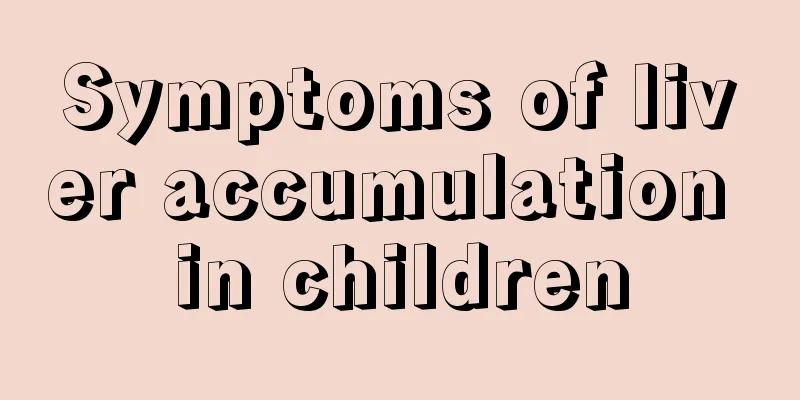Symptoms of liver accumulation in children

|
In fact, liver congestion in children is stomach bloating caused by improper feeding of children, and it may not be a big deal if it happens only occasionally. But if it continues for a long time, it will easily cause children to suffer from indigestion and frequent gastrointestinal diseases. The occurrence of this disease will cause the child to have more obvious symptoms of pediatric liver accumulation. Once this disease occurs, the child's growth and development is likely to be greatly changed. 1. Causes of liver accumulation in children 1. Improper consumption of milk and food will harm the spleen and stomach Eating dairy products in moderation, overeating fatty, sweet, raw and cold foods will damage the spleen and stomach, causing dysfunction of the spleen and stomach, impairing the functions of receiving, transporting and transforming, and causing imbalance in the ascending and descending of food, which will lead to stagnation. If the stagnation lasts for a long time, the spleen and stomach will be further damaged and it will turn into malnutrition. 2. Weak spleen and stomach If the spleen and stomach are weak and deficient, it is difficult for milk and food to be digested, and the milk and food will stagnate and accumulate in the middle part of the body, obstructing the flow of Qi. Over time, this will lead to nutritional imbalance, weight loss, Qi and fluid deficiency, and developmental disorders. Improper consumption of milk and food and weak spleen and stomach are mutually causal. Stagnation can damage the spleen and stomach, and weak spleen and stomach can also cause stagnation. Clinically, they are often mixed with each other. 3. Others Certain chronic diseases and insect infections are also often the cause of this disease. Liver congestion: In traditional Chinese medicine, it refers to a disease in which children have a sallow complexion, thin muscles, and a distended abdomen, which is mostly caused by lack of restraint in diet or parasites in the abdomen. 2. Symptoms of liver accumulation in children 1. Clinical manifestations 1. Dull or pale complexion, fatigue, gradual weight loss, gradual disappearance of subcutaneous fat, loose muscles, dry hair, and in severe cases, poor intellectual development. 2. History of insufficient breast milk, improper feeding, or chronic disease. 2. Main types 1. Mild: The subcutaneous fat in the abdomen, trunk and inner thighs becomes thinner, the muscles are not firm, and the body weight is 15% to 25% lower than normal. 2. Moderate: Subcutaneous fat in the abdomen, trunk, and limbs disappears significantly, there are obvious wrinkles on the inner thighs, muscles are loose, the skin is pale and dry, the face is obviously thin, and the body weight is 25% to 40% lower than normal. 3. Severe: Subcutaneous fat in all parts of the body completely disappears, the cheeks are extremely thin, and the forehead is full of wrinkles, looking like an old man. Skin is dry, inelastic and dull. |
>>: Four-year-old girl has secretions in her underwear
Recommend
How to treat cerebral hypoxia in children?
The difference between humans and animals is that...
Can baby eczema be treated with honeysuckle water?
Throughout history, people both at home and abroa...
How much is the appropriate sleeping cover for a newborn baby?
Good sleep can ensure that you are full of energy...
What to do if your baby's skin is rough
The baby's skin is rough, which is a very abn...
What to do if your child has allergies
Children are mainly prone to inheriting allergies...
What should I do if my seven and a half month old baby is zinc deficient?
Nowadays, many newborn babies suffer from zinc de...
Symptoms of zinc deficiency in six-month-old babies
Generally speaking, babies six months old are no ...
9 foods that make your child smarter
1. Xiaomi Millet contains more nutrients such as ...
What to do if a child has a low-grade fever
When babies are young, the most common phenomenon...
How to quickly relieve toothache in babies
Everyone knows that toothache is not a disease, b...
How many times a day should a baby have bowel movements?
Babies' bodies are very small, and they are n...
My baby has a lot of small red spots on his body. What's going on?
Adults are very concerned about children's he...
Mixed feeding vomits when drinking breast milk
The gastrointestinal structure of babies is diffe...
Causes of bleeding gums in babies
Can you understand your baby’s little thoughts? T...
How to improve children's allergic constitution
Many people have allergic constitution, and this ...









